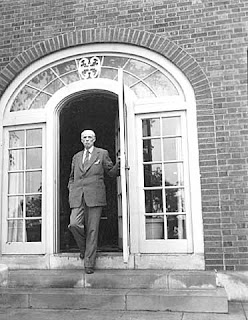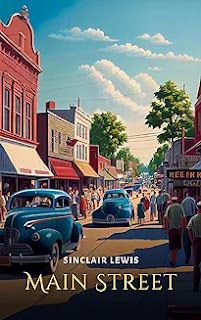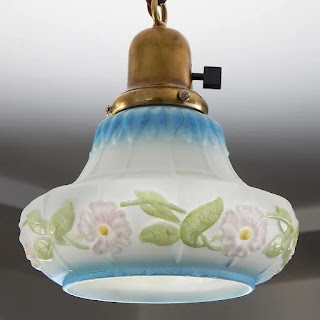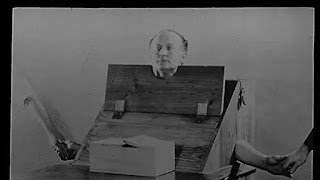In 1985, I was writing an piece for the Minneapolis Star about Sauk Centre's celebration of the 100th anniversary of the birth of native son and Nobel-prize winning author, Sinclair Lewis. I felt connected to Lewis because my husband and I had recently acquired a bed from Lewis's Duluth house. My husband's parents had bought the bed when Lewis sold the house in 1946. They had eventually given it to a neighbor, and three decades later, the neighbor had offered it to us. We kept it. (In fact, I still have that bed and sleep in it every night.)
The bed today, back in DuluthBig Lewis fans, we took occasional trips to Sauk Centre, 100 miles west of Minneapolis, to visit Lewis's boyhood home and see the Main Street that Lewis had made famous--or infamous--in his biting 1920 satirical novel of small town American life. We always stayed at the Palmer House Hotel, where Lewis had worked briefly as a teenager, and which then-owner Al Tingley declared to be haunted by a woman ghost. We'd visit Lewis's grave at Greenwood Cemetery outside of town. Satire aside, Sauk Centre was and still is an interesting historic Minnesota prairie town, thanks to Lewis's connection with it.
In 1998, the Modern Library ranked Main Street #68 on its list of the 100 best English-language novels of the 20th century.
When we first acquired Lewis's Duluth bed in the late 1970s, I was awakened twice
by what sounded like knocks on the headboard. My husband remained asleep
and didn't hear them. He, unlike the other three members of the family,
didn't experience firsthand any of the presumably paranormal incidents in the
house.
In 1985, the south room on the third floor of our house was my writing room. I typed the article about the Lewis centenary on a library table that was set against the wall with two slide-up windows. While writing, I had propped open the window next to the table with a short length of two-by-four board. I worked all afternoon, finally finishing just before dinner time. Ripping the last page from the typewriter roll, I exclaimed, "Done! How do you like that, Red?' As I said "Red", the window slammed shut, scaring me silly. Did Lewis like it? I hope so.
Mark Schorer, when he was researching his 1961 biography of Lewis, said that he felt constantly "haunted" by Lewis. Schorer felt that Lewis, who had died in 1951, was dogging him, pressuring him to dig up more details about his life.
"Sinclair Lewis: An American Life will stand for years to come in the select company of definitive American biographies."--Amazon Books
Indeed, Schorer's description of Lewis's funeral on a record-cold winter day in Sauk Centre in 1951 has some spooky details--for example, store windows on Main Street cracked from the intense cold, the only time that that has happened. When the mourners got to the cemetery, they left their cars' engines running, fearing that they wouldn't be able to re-start them. Lewis's brother Claude carried the urn containing his ashes to the grave site. It was bitterly cold and completely still. Claude decided (Lewis would have loved this) that the urn was too good to bury, so he removed the cover and proceeded to pour the ashes into the ground. At that point, a huge gust of wind suddenly swept over the grave site and "blew old Red over twenty acres of Stearns County," as one observer put it.
* * *
One incident that happened in that same room on the third floor stands out as different from all the rest. It probably had nothing to do with Lewis, but it was the one-and-only time I experienced a nocturnal paranormal visitor.
Because I didn't want to be awakened when my husband had to get up at 4:30, I decided to sleep in the bed on the third floor. Around 3 a.m., I was awakened by sensing a man coming into the room and coming to stand over me at the right side of the bed. I turned over to ask why I had been awakened. I opened my eyes--and saw in the dim illumination from the streetlight that no one was in the room. I immediately got up and went to the top of the stairs, preparing to call out. But the stairwell was pitch dark, and the door at the bottom was closed; all was dead-still in the house.
The thought screamed in my head. "Ghost!" Curiously, instead of being freaked out, I returned to bed and immediately fell asleep. It was almost as if I'd been drugged. The next day when I asked the rest of family if any of them had come up to the third floor during the night, they all said no. Was it Frank--or maybe Red, wondering why I was not in the Lewis bed on the second floor? We'll never know. I never slept in that room again, although my daughter M did when it became her room. She had no nocturnal visitors.
After that experience, I recalled that a Minneapolis woman had told me of a similar reaction that she had when she was awakened by an apparition while she was house sitting. Sensing a presence, she woke up and saw a woman standing across the room, staring at her. She looked at the figure, who was clearly unhappy with her presence, then immediately fell back into a deep sleep. This happened three times until she learned from the owner of the house that the ghost was a deceased previous owner, the protective spirit of the house. (Like Frank, I might add.)
* * *"Writers have a rare power not given to anyone else: we can bore people long after we are dead." ~ Sinclair Lewis














































